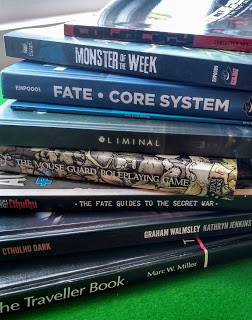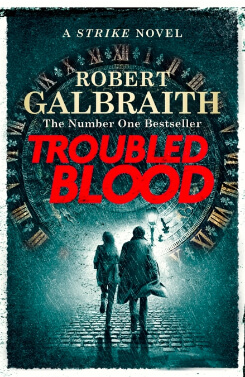This is part three of my campaign write-up for The Dee Sanction. Jon is playing Margaret Chatwyn, temple clerk, and Terry is playing gardener Samuel Hodgeson. You can read part 1 here and part 2 here.
Session #8: Lady Viola and the blood crabs
This was a big session. The players burned through a lot of clues and affected the bad guys’ plans in ways I needed to think about.
We started at the Wessex estate, where the PCs met Mrs Brisket and Nurse Staunton (Viola’s nurse from before she was married). Nurse Staunton told them about Viola sneaking off to act, disguised as ‘Victor Smith.’ However, Viola changed after visiting her Suffolk cousins at the end of September. (Viola never went to Suffolk, but the PCs never learned this.)
 |
| The Wessex estate |
However, before they can meet Viola, the PCs must get past the fearsome Miss Kent.
Miss Kent entered the kitchens with a jug of water, eyeing the PCs suspiciously. Margaret dulled Miss Kent’s senses using magic and brought her into the scullery to examine her for fen fever.
With Miss Kent distracted, Mrs Brisket and Nurse Staunton took Samuel to see Viola. They found her torso heavily bandaged, beneath which were hideous occult scars and horrible blood mite-leech things.
Downstairs, Miss Kent realised something was up, and she and Margaret scuffled. Miss Kent blistered Margaret’s arm and escaped the scullery, locking the door behind her. Margaret tried to magic an escape by corroding the lock, but her magic misfired (Jon rolled a 1) and she instead summoned demonic flies that angrily buzzed about her.
Upstairs, Samuel used a candle to remove the horrible creatures and captured them in a jar. Miss Kent burst into Viola’s bed-chamber, saw what was going on, and fled. Samuel partially blinded her (clouding her eyes) and tackled her on the stairs. The PCs bound Miss Kent, but she refused to talk. To make her compliant, Samuel tainted her blood—but misjudged his spell and Miss Kent became critically ill with blood poisoning.
Samuel and Margaret were now suspicious of Lord Wessex, who was preparing for a royal visit at Kenilworth. Was Queen Elizabeth in danger?
Samuel and Margaret brought Miss Kent and the creatures back to their base, where Philip (an NPC) had learned that the Golden Rose was often seen at a haberdashery warehouse owned by William Gynn.
And there we left it.
Following that, I had decisions to make:
- With Viola freed of the blood creatures, the School of Night presumably knows something has gone wrong. How do they react?
- If Abaddon, the blood crabs’ monstrous mother, knows what happened, how does it react?
- How will Dee and Walsingham react to anything the players tell them?
Session #9: The creature in the basement
Due to fatigue on my part, this was a short session. The PCs sent a full report of the events at Egham to Dee (via the sulphurous Master Garland), along with Miss Kent and a blood crab.
That left me with a problem, as I didn’t want Dee to solve everything for the players. The PCs were the stars, so I presented Dee as offhand, erratic, and busy with affairs of state. But the PCs have demonstrated a threat to the queen, so I needed to react.
While they waited for a response from Dee, the players visited William Gynn’s haberdashery warehouse at night. There they found a basement containing bodies, occult symbols, and signs that something had been recently moved. They learned that the warehouse was rented by Francis Reed and tried to track him down.
Tell me what goes wrong? At one point, Margaret used her magic to corrode the lock of Francis Reed’s house—and failed. So I asked Jon what he thought might go wrong, and he suggested that the wooden door catch fire. And as it has been raining, it had to be magical fire, so we made it blue. That’s much more interesting than just having the spell fail—and I found that the players were always very creative in what can cause them problems. (I also talk about this approach here.)
You’re on the right track: I try not to let failed die rolls derail an investigation. For example, Terry asked if there was any paperwork in the basement. Unfortunately, he failed his roll (and was out of Fortune points), so he found nothing in the basement. But as the office would be a better place to search, I encouraged them to search the rest of the warehouse. (I’ve touched on this before.)
House rule #2: As this is a long, multi-session adventure, I ruled that Fortune points recharge every other session rather than at the end of the adventure.
Planning for Session #10: I needed to get the PCs to Kenilworth, as that’s where the action now is. Here’s how I’m going to this:
- One of the clues they have yet to find is a wagon carrying a long wooden box bound in chains that left the warehouse five days ago. This tells them that whatever was in the warehouse is on the move. (I couldn’t work out when to work it into the story given they were sneaking around at night—I’ve hinted that they might want to visit the warehouse during the day.)
- Dee will ask them to go to Kenilworth and check that things are okay for the queen’s visit. I will let the players come up with a story they can use, but Dee and Walsingham can provide official details, a letter of introduction, or whatever the players decide they need. Dee will also provide hints to the nature of the monster.
House rule #3: I’ve quietly dropped the Black Seal Amulets (page 31) that allow the Agents to communicate directly with Dee and each other. They’re too modern for me, and advice shouldn’t be only a phone call away.
Session #10: William Gynn’s haberdashery warehouse
These are the events I prepared for this session, with my comments (in italics).
- Captain Tallow is found dead, his throat slit. (One of the NPCs reported this news. ‘Covering their tracks,’ one of the players commented. Indeed.)
- Dee instructs the PCs to go to Kenilworth to see if there is a problem. Walsingham will provide a letter of introduction. (The players had realised that they needed to go to Kenilworth. To give them the authority they needed, they went as Queen Elizabeth’s advance security, checking for Catholic dissidents.)
- Mysterious attackers (the School of Night) attack the chapel while the PCs are out and steal anything there. (I didn’t use this as Jon and Terry have been moving quickly. I would have used this to add pressure were they dawdling.)
- Marlowe visits Viola to work out what has gone wrong with the puppet. Viola refuses to see him, and he is barred by the staff. Viola and her loyal staff then decamp to her cousins in Suffolk to get away from Wessex. (This happened in the background, following the events of Session #8. The players didn’t learn of it as they have shown no more interest in Viola.)
And secrets and clues for the players to find:
- A wagon with a long wooden box bound in chains left the warehouse four days ago—by boat upstream and then overland to Kenilworth. (The PCs failed to learn this, through a series of unlucky rolls. However, they worked it out based on what they knew.)
- Francis Reed is an associate of Christopher Marlowe. (Revealed at Reed’s lodging house.)
- Blood crabs react badly to focussed sunlight—use a glass. (Dee provided this information when instructing the PCs to go to Kenilworth.)
- In De Principibus et Regibus Daemoniorium there is mention of a demon with blood-sucking children. The demon’s name is Abaddon. (Dee also provided this.)
- Viola was never at her cousin's. (This clue has rolled over for a few sessions now. The focus moved away from Viola, and the clue was never revealed.)
- A rich lady, accompanied by her maid, visited the warehouse in early October. The witness didn’t see them leave. (The PCs didn’t discover this. This is how Viola was infected with the blood crabs. The maid is Miss Kent.)
During session #10, the Agents revisited the warehouse and Francis Reed’s lodgings. Thanks to terrible rolls, they struggled to find clues. We ended the session with Dee’s instruction to go to Kenilworth.
London to Kenilworth is about 100 miles. Given the poor state of Tudor roads (although they can take a boat to Oxford), we worked out that it would take a couple of weeks to transport a heavy load from London to Kenilworth. However, given that the box only left a few days ago, the PCs should be able to beat it to Kenilworth if they ride fast.
So that’s where we will start next week’s session: Kenilworth.
Next time
So what will our heroes do at Kenilworth? Or will they derail all my preparation and do something different? Find out next time when we conclude our campaign.
Now that we’ve finished, I’ve written up the adventure (Abaddon’s Puppet) and posted it on my Itch.io page.
And here are Tales of Terror suitable for The Dee Sanction.









